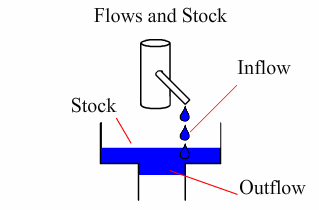If you deposit $100 at the end of every month into your emergency fund account, you would have a balance of $1200 ($100*12) at the end of the year absent any emergency needs. The monthly deposits are flows and the year-end balance is a stock which accumulates the flows. We can call the monthly deposits saving (as flows) and the year-end balance savings (as stocks).
If the emergency fund is tapped, these expenses are flows out of the account. At the end of the year, the balance should reflect the difference between the inflows and outflows.
When inflows exceed outflows, a positive balance (aka surplus) builds up. When outflows exceed inflows, a negative balance (aka deficit) results. If the deficit is covered by borrowing, the negative balance becomes a debt. Thus, deficit flows add to the debt stock.

For example, the federal government runs a budget deficit every year by spending more than it taxes. These deficits are financed by borrowing mostly from overseas and they add to the ever expanding public debt. Because of these constant accumulations, total federal debt is projected to exceed 100% of GDP in 2012 while the annual deficits average over 10% of GDP (Economist 11/21/2009. BW 2/15/2010).
Another application of the concepts of flows vs stocks is the difference between investment and productive capacity. Investment in new capital goods is a flow. But because capital goods last more than the flow period, they accumulate as productive stocks. These accumulated stocks are the productive infrastructures such as roads and bridges, houses and commercial buildings, and software and hardware. The depreciation expenses set aside to offset wear and tear represent outflows just as new investment represents inflows. If new investment falls short of the wear and tear, the physical infrastructure deteriorates. Many roads, bridges, and sewage systems are in need of expensive repairs, but many governments have not put aside adequate depreciation allowances for these purposes.
Stocks and flows are linked because inflows are not instantly perishable. If all flows are instantly perishable, there would be no stocks. Thus, the stocks we see at any one point of time are what are left over from past inflows at various stages of depreciation. For example, GDP is a flow because it is the sum of all the flows during a year. Some of the flows occurring in January might well have perished by the end of the year. What we see at the end of the year are physical objects that have not perished during the year. So GDP refers to the sum of what occurs over a year and not what is left over at the end of year.
Stocks are important because they are the infrastructures for living and producing. Rich countries are blessed with large stocks accumulated over time. Low inflows and outflows can keep the stocks constant. But large inflows and outflows are needed to keep the vintage of the stocks young as inflows bring along more up-dated technology and outflows get rid of obsolete technology. That is why you will find more modern airports and faster trains in rapidly growing China while the subway systems in slow-growing developed countries are antiquated. By the same token, human populations with high birth rates and high death rates are younger than equal-sized populations with low birth rates and low death rates.
Flows: GDP, consumption, investment, saving, trade deficit and surplus, budget deficit and surplus, aggregate demand and supply.
Stocks: Debt, infrastructure, buildings, wardrobes, memories, library, circulating currency, computer software and hardware, databases, cars in your garages, antiques.
----
- BW. “U.S. debt: it’s not dark yet, but it’s getting there.” 2/15/2010.
- Economist. “Stemming the tide.” 11/21/2009.
- Wikipedia.com. “Stock and flow.” Cited 5/19/2010.
